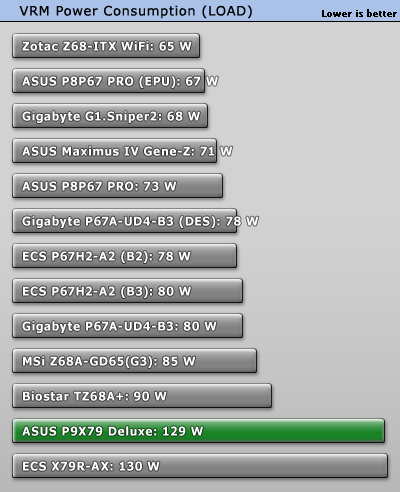 54
54
ASUS P9X79 Deluxe Intel LGA 2011 Review
CPU Performance Results »Test System
| Test System | |
|---|---|
| CPU: | Intel X3960 (ES) 3.3 GHz, 15 MB Cache |
| Memory: | 16 GB DDR3 (2x 4 GB) G.Skill F3-17000CL9Q-16GBZH |
| Cooling: | Noctua NH-C14 |
| Motherboard: | ASUS P9X79_Deluxe Intel X79 Express, BIOS ver 0802 |
| Video Card: | Sapphire Radeon HD 6950 2 GB |
| Harddisk: | Western Digital Caviar SE 16 WD5000AAKS 500GB SATA2 Seagate Barracuda LP ST2000DL003 2TB SATA 6 Gb/s iomega eGo BlackBelt 500GB USB3.0 |
| Power Supply: | Silverstone Strider GOLD 750W |
| Case: | Test Bench |
| Software: | Windows 7 64-bit, ATI Catalyst 11.11 |
Initial Setup
Setting up the ASUS P9X79 Deluxe proved an easy task, no different than any other motherboard, with the JEDEC 1600 MHz 11-11-11-31 1.5V profile of our G.Skill DIMMs booting right up without any issue. The OS install went perfectly, and no issues were noticed at any point during our testing period, even when overclocking.
PWM Power Consumption
Since one of our first tasks was to truly verify system stability, while doing so we measure CPU power consumption. We isolate the power coming through the 8-pin ATX connector using an in-line meter that provides voltage and current readings, as well as total wattage passed through it. While this may not prove to isolate the CPU power draw in all instances, it does serve as a good indicator of board efficiency and effective VRM design.

The ASUS P9X79 Deluxe put up some pretty impressive numbers on 8-pin power consumption. First, in idle mode, a draw of just three watts was noticed, a full 15 watts lower than the last Intel X79 Express product we tested. At load, the situation was a bit different, however, with 129 watts drawn via the 8-pin EPS connector, just one watt less than the ECS X79R-AX.
Apr 23rd, 2025 20:49 EDT
change timezone
Latest GPU Drivers
New Forum Posts
- Companies should be called out for this (88)
- RTX 5070ti - Which MSRP model has the better/quieter cooler design, ASUS Prime, Gigabyte Windforce or PNY? (3)
- Share your AIDA 64 cache and memory benchmark here (3055)
- What are you playing? (23449)
- To distill or not distill what say ye? (73)
- Just for lolz, Post your 3DMark2001SE Benchmark scores! (96)
- Help getting a mini pc (0)
- RX 9000 series GPU Owners Club (498)
- 5060 Ti 8GB DOA (255)
- DTS DCH Driver for Realtek HDA [DTS:X APO4 + DTS Interactive] (2151)
Popular Reviews
- NVIDIA GeForce RTX 5060 Ti 8 GB Review - So Many Compromises
- ASUS GeForce RTX 5060 Ti TUF OC 16 GB Review
- ASRock X870E Taichi Lite Review
- Upcoming Hardware Launches 2025 (Updated Apr 2025)
- Sapphire Radeon RX 9070 XT Pulse Review
- Colorful iGame B860M Ultra V20 Review
- Sapphire Radeon RX 9070 XT Nitro+ Review - Beating NVIDIA
- NVIDIA GeForce RTX 5060 Ti PCI-Express x8 Scaling
- AMD Ryzen 7 9800X3D Review - The Best Gaming Processor
- ASUS GeForce RTX 5080 TUF OC Review
Controversial News Posts
- NVIDIA GeForce RTX 5060 Ti 16 GB SKU Likely Launching at $499, According to Supply Chain Leak (182)
- NVIDIA Sends MSRP Numbers to Partners: GeForce RTX 5060 Ti 8 GB at $379, RTX 5060 Ti 16 GB at $429 (127)
- NVIDIA Launches GeForce RTX 5060 Series, Beginning with RTX 5060 Ti This Week (115)
- Nintendo Confirms That Switch 2 Joy-Cons Will Not Utilize Hall Effect Stick Technology (105)
- Nintendo Switch 2 Launches June 5 at $449.99 with New Hardware and Games (99)
- Sony Increases the PS5 Pricing in EMEA and ANZ by Around 25 Percent (85)
- NVIDIA PhysX and Flow Made Fully Open-Source (77)
- Windows Notepad Gets Microsoft Copilot Integration (75)

